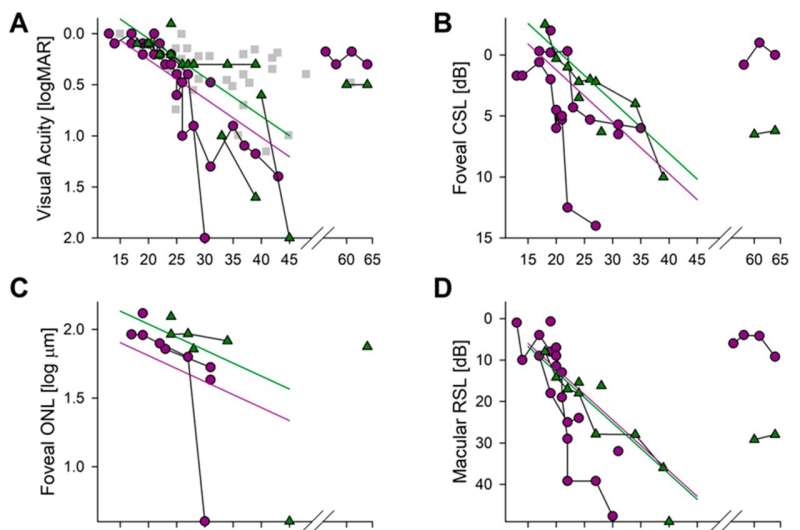This article has been reviewed according to Science X's editorial process and policies. Editors have highlighted the following attributes while ensuring the content's credibility:
fact-checked
trusted source
proofread
ALG6 acts as a modifier gene in the inherited genetic eye disease retinitis pigmentosa 59

Modifier genes add complexity to precision medicine. A modifier gene is one that has genetic variants such as single nucleotide changes that differ from the most common sequence in the population. These variants do not cause disease by themselves, but can lessen or exacerbate a different genetic disease phenotype by unknown mechanisms.
Steven Pittler, Ph.D., at the University of Alabama at Birmingham, has sought to find modifier genes for the hereditary eye disorder retinitis pigmentosa type 59. After onset in one's late teens, RP59 slowly causes blindness over years or decades by attacking the retina at the back of the eye. RP59 is caused by a single nucleotide change that alters one amino acid in the gene that encodes dehydrodolichyl diphosphate synthase, or DHDDS. DHDDS is part of a two-subunit enzyme that is required for protein glycosylation, which is a covalent addition of carbohydrates to the protein.
The DHDDS mutation in RP59 leads to alteration of synaptic transmission and retinal degeneration. However, the disease does not appear to cause problems anywhere else in the body.
Protein N-glycosylation and other protein glycosylation pathways require more than 35 enzymes. These protein modifications are crucial for function in all cells of the body, including cell–cell recognition, immune response, extracellular matrix formation, ion and solute transport, and signal transduction.
Using a panel of 11 RP59 patients who all have an identical, disease-causing point mutation in DHDDS, Pittler and colleagues examined five other genes involved in protein N-glycosylation for evidence of a phenotype-modifier effect. Of the five genes, only one, ALG6, showed a variation in its genetic sequence that correlated with altered phenotypes among the RP59 patients. The ALG6 variant changes amino acid number 304 in the ALG6 protein from phenylalanine to serine.
The team's paper is published in the International Journal of Molecular Sciences.
Five RP59 patients were heterozygous for the ALG6 modifier variant, meaning they had two different alleles. The remaining six patients showed the most common allele sequence, meaning no DNA sequence variation in either allele of their ALG6 genes. To show that the ALG6 variant was non-pathogenic by itself, the researchers also included three control subjects—people without RP59 (no change from the most common sequence of DHDDS). One control lacked the ALG6 variant in both copies of the ALG6 gene, while the other two were heterozygous and homozygous for the ALG6 variant.
Pittler and colleagues at UAB, the University of Pennsylvania, and the State University of New York-University at Buffalo examined data collected over five decades for six clinical parameters of retinal function and structure in the 11 RP59 patients.
Their report shows that one parameter analyzed—extra-macular rod sensitivity loss—significantly delayed peripheral rod degeneration over 30 years in patients who were heterozygous for the ALG6 variant. Furthermore, a trend was observed in three other parameters that collectively suggested a diminished macular cone photoreceptor health in individuals heterozygous for the ALG6 variant.
"This work represents an early effort in what will become a major part of precision medicine involving big science, artificial intelligence-driven analysis of genetic associations," Pittler said. "Overall, these results indicate a potential deficit in macular cone function and simultaneous preservation of peripheral rod health in RP59 patients who co-express a heterozygous phenylalanine-304-to-serine mutation in ALG6."
"Thus, modifier gene polymorphisms may account for a significant portion of phenotypic variation observed in human genetic disease. However, in this case, the consequences of the polymorphisms are counterintuitively complex in terms of rod and cone populations affected in different regions of the retina."
In the mammalian retina, rods and cones are the two types of photoreceptor cells. Cones provide color vision and largely cluster in the small, central foveal and macular region of the retina that allows sharp detailed vision in bright light. Rods function at lower light levels facilitating dim light vision, which is mediated by the more peripheral areas of the retina outside of the macula.
The first author of the study, "Inherited retinal degeneration caused by dehydrodolichyl diphosphate synthase mutation—Effect of an ALG6 modifier variant," is Elisha Monson, a graduate of the UAB Chemistry program now in medical school at the University of Iowa.
"Taking this project from idea to outcome offered an excellent foundation in modern research and a unique glimpse into the future of precision medicine. I am especially grateful to Dr. Pittler and my many mentors in the UAB Department of Chemistry for their generous support," said Monson.
Co-authors with Pittler and Monson are Artur V. Cideciyan, Alejandro J. Roman, Alexander Sumaroka, Malgorzata Swider, Vivian Wu, Iryna Viarbitskaya and Samuel G. Jacobson, Center for Hereditary Retinal Degenerations, University of Pennsylvania, Philadelphia; and Steven J. Fliesler, State University of New York-University at Buffalo.
More information: Elisha Monson et al, Inherited Retinal Degeneration Caused by Dehydrodolichyl Diphosphate Synthase Mutation–Effect of an ALG6 Modifier Variant, International Journal of Molecular Sciences (2024). DOI: 10.3390/ijms25021004





















